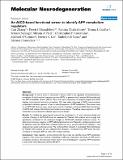| dc.contributor.author | Zhang, Can | |
| dc.contributor.author | Khandelwal, Preeti J | |
| dc.contributor.author | Chakraborty, Ranjita | |
| dc.contributor.author | Cuellar, Trinna L | |
| dc.contributor.author | Sarangi, Srikant | |
| dc.contributor.author | Patel, Shyam A | |
| dc.contributor.author | Cosentino, Christopher P | |
| dc.contributor.author | O'Connor, Michael | |
| dc.contributor.author | Lee, Jeremy C | |
| dc.contributor.author | Tanzi, Rudolph Emile | |
| dc.contributor.author | Saunders, Aleister J | |
| dc.date.accessioned | 2011-01-27T12:04:18Z | |
| dc.date.issued | 2007 | |
| dc.identifier.citation | Zhang, Can, Preeti J. Khandelwal, Ranjita Chakraborty, Trinna L. Cuellar, Srikant Sarangi, Shyam A. Patel, Christopher P. Cosentino, Michael O'Connor, Jeremy C. Lee, Rudolph E. Tanzi, and Aleister J. Saunders. 2007. An AICD-based functional screen to identify APP metabolism regulators. Molecular Neurodegeneration 2: 15. | en_US |
| dc.identifier.issn | 1750-1326 | en_US |
| dc.identifier.uri | http://nrs.harvard.edu/urn-3:HUL.InstRepos:4688061 | |
| dc.description.abstract | Background: A central event in Alzheimer's disease (AD) is the regulated intramembraneous proteolysis of the β-amyloid precursor protein (APP), to generate the β-amyloid (Aβ) peptide and the APP intracellular domain (AICD). Aβ is the major component of amyloid plaques and AICD displays transcriptional activation properties. We have taken advantage of AICD transactivation properties to develop a genetic screen to identify regulators of APP metabolism. This screen relies on an APP-Gal4 fusion protein, which upon normal proteolysis, produces AICD-Gal4. Production of AICD-Gal4 induces Gal4-UAS driven luciferase expression. Therefore, when regulators of APP metabolism are modulated, luciferase expression is altered. Results: To validate this experimental approach we modulated α-, β-, and γ-secretase levels and activities. Changes in AICD-Gal4 levels as measured by Western blot analysis were strongly and significantly correlated to the observed changes in AICD-Gal4 mediated luciferase activity. To determine if a known regulator of APP trafficking/maturation and Presenilin1 endoproteolysis could be detected using the AICD-Gal4 mediated luciferase assay, we knocked-down Ubiquilin 1 and observed decreased luciferase activity. We confirmed that Ubiquilin 1 modulated AICD-Gal4 levels by Western blot analysis and also observed that Ubiquilin 1 modulated total APP levels, the ratio of mature to immature APP, as well as PS1 endoproteolysis. Conclusion: Taken together, we have shown that this screen can identify known APP metabolism regulators that control proteolysis, intracellular trafficking, maturation and levels of APP and its proteolytic products. We demonstrate for the first time that Ubiquilin 1 regulates APP metabolism in the human neuroblastoma cell line, SH-SY5Y. | en_US |
| dc.language.iso | en_US | en_US |
| dc.publisher | BioMed Central | en_US |
| dc.relation.isversionof | doi://10.1186/1750-1326-2-15 | en_US |
| dc.relation.hasversion | http://www.ncbi.nlm.nih.gov/pmc/articles/PMC2071909/pdf/ | en_US |
| dash.license | LAA | |
| dc.title | An AICD-based functional screen to identify APP metabolism regulators | en_US |
| dc.type | Journal Article | en_US |
| dc.description.version | Version of Record | en_US |
| dc.relation.journal | Molecular Neurodegeneration | en_US |
| dash.depositing.author | Tanzi, Rudolph Emile | |
| dc.date.available | 2011-01-27T12:04:18Z | |
| dash.affiliation.other | HMS^Neurology-Massachusetts General Hospital | en_US |
| dc.identifier.doi | 10.1186/1750-1326-2-15 | * |
| dash.contributor.affiliated | Zhang, Can | |
| dash.contributor.affiliated | Tanzi, Rudolph | |


